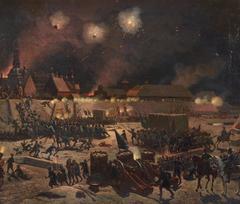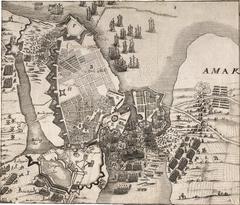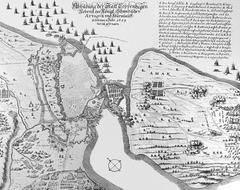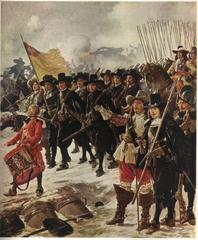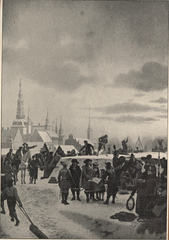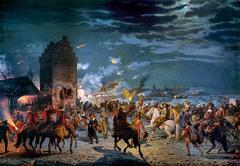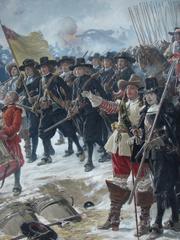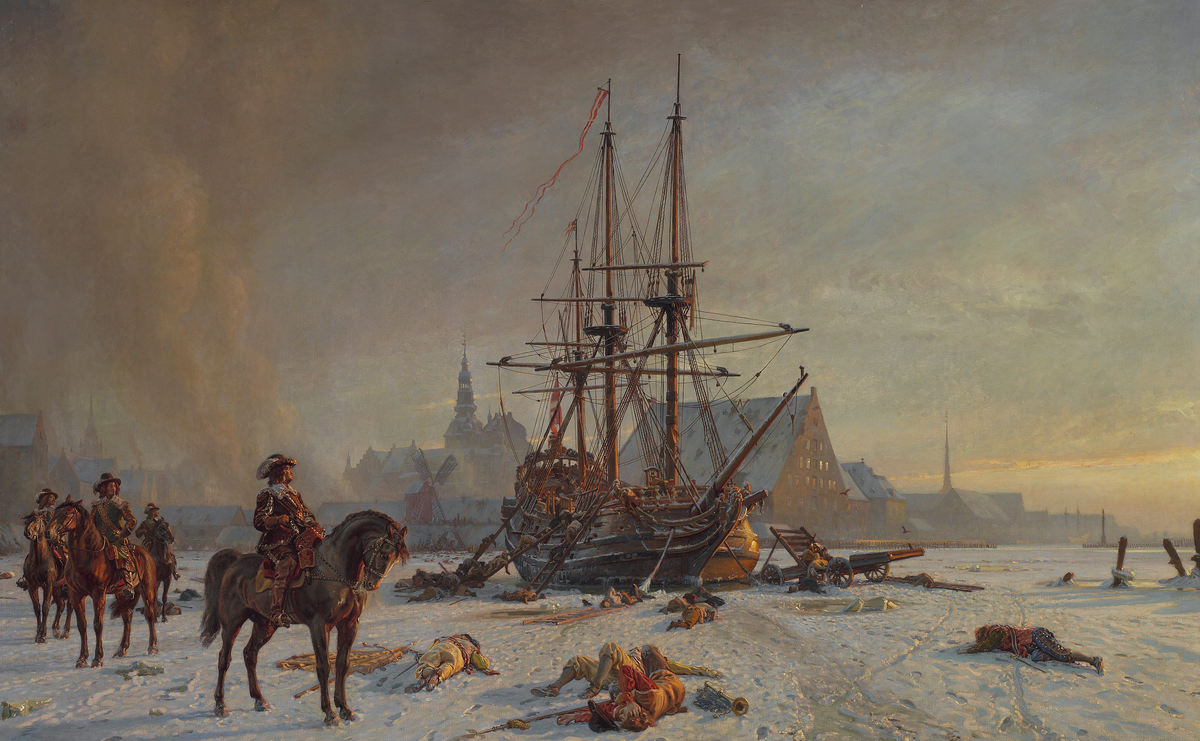
Assault on Copenhagen: Visiting Hours, Tickets, and Guide to Copenhagen Historical Sites
Date: 14/06/2025
Introduction to the Assault on Copenhagen Site and Its Historical Significance
The Assault on Copenhagen stands as a cornerstone of Denmark’s history, encompassing two monumental events that have profoundly influenced the city’s identity and resilience. The first, the 1659 siege during the Second Northern War, and the second, the 1807 bombardment amidst the Napoleonic Wars, both underscore Copenhagen’s strategic maritime importance and the enduring spirit of its citizens. Today, these episodes are commemorated through well-preserved fortifications, engaging museums, and evocative memorials, giving visitors a unique window into the events that shaped the Danish capital (Wikipedia; danishhistory.github.io; Wikipedia; Medium).
This guide delves into the geopolitical context and military operations of both assaults, their cultural and urban legacies, and detailed practical information for exploring key historical sites such as Kastellet fortress, the old ramparts, and local museums. Whether you are interested in guided tours, museum exhibitions, or immersive experiences like the “Assault On Copenhagen” escape room, this resource will help you plan a memorable and insightful visit.
For further exploration, official tourism platforms provide guided tours, interactive maps, and multimedia resources to enrich your understanding of Copenhagen’s rich military history (visitcopenhagen.com; copenhagen.com).
Table of Contents
- Introduction
- The Geopolitical Context of the Assault on Copenhagen (1807)
- The British Military Operation
- The Bombardment and Its Impact
- Surrender and Aftermath
- International Repercussions and Legacy
- Visiting Historical Sites and Memorials in Copenhagen
- The Historical Context of the Assault on Copenhagen (1659)
- Cultural Significance and Legacy
- Visitor Information: Tickets, Hours, and Tours
- Visual and Interactive Experiences
- Practical Visitor Tips
- FAQ: Visiting the Assault on Copenhagen Sites
- Cultural Insights and Local Customs
- Nearby Attractions
- Essential Visitor Information
- Plan Your Visit and Stay Connected
- Assault On Copenhagen Escape Room: Hours, Tickets, and Visitor Guide
- Summary and Visitor Recommendations
- References and Additional Resources
The Geopolitical Context of the Assault on Copenhagen (1807)
The 1807 Assault on Copenhagen, known as the Second Battle of Copenhagen, unfolded amidst the Napoleonic Wars. At the time, Denmark-Norway was a neutral power with significant naval strength. The rivalry between Napoleonic France and Great Britain placed Denmark in a precarious position as Napoleon’s Continental System aimed to choke British trade (Wikipedia). Fearing that Denmark’s fleet might fall into French hands, Britain made unsuccessful demands to secure the fleet, prompting a military response (danishhistory.github.io).
The British Military Operation
On August 16, 1807, British forces numbering around 30,000 landed near Copenhagen, vastly outnumbering the 13,000 Danish defenders. The British fleet, led by Admiral Gambier, issued an ultimatum for Denmark to surrender its navy. After refusal, the bombardment began on September 2, unleashing a ferocious attack with Congreve rockets and artillery (danishhistory.github.io; Wikipedia).
The Bombardment and Its Impact
The 1807 bombardment was one of the first examples of terror bombing in Europe, resulting in widespread fires, destruction, and civilian casualties. While early estimates suggested high death tolls, modern research places civilian deaths at around 200, with 768 injured and over 1,000 buildings destroyed. The devastation altered the city’s urban landscape and highlighted the vulnerability of civilian populations in modern warfare (Wikipedia; danishhistory.github.io).
Surrender and Aftermath
On September 5, Denmark sought peace, surrendering its fleet and naval stores to Britain, with shipyards intentionally damaged to prevent future naval resurgence. This marked a significant decline in Denmark’s maritime power and forced the country into the Continental System, though its military role remained limited (danishhistory.github.io; Wikipedia).
International Repercussions and Legacy
The attack on a neutral nation drew widespread European condemnation and contributed to the Anglo-Russian War of 1807. The term “to Copenhagenize” emerged, referring to preemptive neutralization of a threat. The events of 1807 are now recognized as a turning point in both Danish and European history, underscoring the enduring impact of conflict on urban and national identity (Wikipedia).
Visiting Historical Sites and Memorials in Copenhagen
Copenhagen’s cityscape still bears witness to these historical events. Key sites include:
- Holmen Naval Base: Tours available during special events; offers a glimpse of historic docks and naval buildings. Check official tourism websites for dates and ticket information.
- National Museum of Denmark: Features artifacts and exhibitions on the Napoleonic Wars and the 1807 bombardment. Open daily, usually 10:00–17:00; adult tickets approx. 95 DKK.
- Danish War Museum (Krigsmuseet): Focuses on Denmark’s military history. Open Tuesday to Sunday, 10:00–16:00; tickets around 60 DKK.
Additional sites such as Nyhavn harbor, Amalienborg Palace, and Christiansborg Palace are within walking distance and offer further insights into Copenhagen’s royal and military history (copenhagenyouthhostel.dk; visitcopenhagen.com).
Accessibility and Travel Tips
- Transport: Most sites are easily reached by public transport or bike.
- Accessibility: Many locations are wheelchair accessible, but check specific sites for details.
- Preparation: Dress for the weather and wear comfortable walking shoes.
The Historical Context of the Assault on Copenhagen (1659)
The February 1659 siege was a critical event during the Second Northern War, where Copenhagen faced an overwhelming Swedish attack. Despite harsh conditions and previous territorial losses, the city’s defenders, bolstered by Dutch support, repelled the assault, preserving Danish sovereignty and forging a legacy of resilience (Wikipedia; Medium; Mapzen).
Cultural Significance and Legacy
Symbol of National Resilience
The defense of Copenhagen in 1659 is celebrated as a defining moment in Danish unity and independence. The collaborative resistance of citizens, Danish soldiers, and Dutch allies remains a source of national pride (Wikipedia; Medium).
Urban Development and Historical Sites
The siege influenced city planning, leading to the enhancement of fortifications and shaping modern Copenhagen’s layout. Remnants of ramparts and bastions, as well as monuments like the Rytterstatue of Absalon, connect visitors with this military heritage (Kopenhagen.com; True Scandinavia).
Danish-Dutch Relations
The Dutch fleet’s intervention established enduring ties between Denmark and the Netherlands, commemorated through cultural exchanges and historical remembrance (Wikipedia; Medium).
Visitor Information: Tickets, Hours, and Tours
- City Ramparts and Bastions: Open year-round, free of charge.
- Copenhagen City Museum & National Museum of Denmark: Open daily, typically 10:00–17:00; tickets range from 80–120 DKK.
- Guided Tours and Events: Themed tours and seasonal reenactments are available through local operators and museums, especially during summer.
Check visitcopenhagen.com for the latest updates and event schedules.
Visual and Interactive Experiences
Enhance your visit with:
- Interactive Maps: Available at Copenhagen Visitor Service.
- Virtual Tours/Documentaries: Online resources offer immersive perspectives on the sieges and their impact.
Practical Visitor Tips
- Transportation: Copenhagen’s airport and public transport make the city highly accessible. Biking is popular and efficient (happytowander.com).
- Weather: Danish weather is variable; dress in layers and bring a waterproof jacket (lonelyplanet.com).
- Payments: The city is largely cashless; credit/debit cards are widely accepted.
- Safety: Copenhagen is very safe. Most sites are accessible to those with mobility challenges, though some older fortifications may have limitations.
FAQ: Visiting the Assault on Copenhagen Sites
- Are there guided tours? Yes, many museums and companies offer dedicated tours focusing on the assaults.
- Are ramparts free to visit? Yes, most outdoor sites are free and open year-round.
- Is the area accessible? Most major sites are accessible, but check in advance for specific needs.
- How do I buy museum tickets? Online or at the entrance; the Copenhagen Card is a cost-effective option for multiple attractions.
Cultural Insights and Local Customs
Copenhageners commemorate their history with pride. On Denmark’s Liberation Day (May 4th), candles in windows symbolize endurance through adversity—an echo of the city’s resilience during past sieges (copenhagen.com).
Nearby Attractions
Complement your historical explorations with visits to Amalienborg Palace, the National Museum, and Christiansborg Palace. These sites provide broader context on Danish royal and political history (visitcopenhagen.com).
Essential Visitor Information
- Opening Hours: Outdoor sites open year-round; museums generally 10:00–17:00.
- Admission Fees: Outdoor sites are free; museums charge entry (see individual sites for details).
- Facilities: City center offers plentiful amenities including restrooms, cafes, and restaurants.
- Events: Look for historical reenactments and commemorative activities around significant anniversaries.
Interactive maps and virtual tours are accessible through official tourism websites.
Plan Your Visit and Stay Connected
For the latest updates, tour bookings, and travel tips, download the Audiala app. Follow us online and check related articles for deeper insights into Copenhagen’s history.
Assault On Copenhagen Escape Room: Hours, Tickets, and Visitor Guide
Assault On Copenhagen is a centrally located, immersive escape room attraction that brings Danish history to life through interactive storytelling and themed puzzles. It’s ideal for visitors looking for a unique, hands-on way to connect with Copenhagen’s heritage.
- Location: Within walking distance of major landmarks such as Tivoli Gardens and Nyhavn.
- Visiting Hours: Typically 10:00–22:00 daily; confirm on the official website before visiting.
- Tickets: Book online in advance, especially during peak times. Prices range from 200–350 DKK per person. Group sizes are usually 2–6 participants.
- Age Suitability: Most rooms are suitable for ages 12 and up; check for family-friendly options.
- Accessibility: Contact in advance for specific accommodations.
- Payment: Most major credit cards accepted; tipping is optional (TravelPander; VisitCopenhagen).
Combine your visit with nearby attractions and enjoy Copenhagen’s thriving cultural scene. Remember to arrive early for your session and adhere to venue guidelines.
Summary and Visitor Recommendations for the Assault on Copenhagen Site
The Assault on Copenhagen encapsulates stories of conflict and perseverance that continue to shape Denmark’s capital. From preserved fortresses and evocative museums to interactive escape rooms, visitors can experience Copenhagen’s dramatic history in vivid and engaging ways. Comprehensive visitor information—covering hours, tickets, accessibility, and tours—ensures a seamless and enriching journey. For further convenience, the Copenhagen Card offers savings on many attractions.
Stay informed about ongoing events and exhibitions through official tourism channels and enhance your visit with interactive guides from the Audiala app. By exploring these sites, you gain a unique perspective on Copenhagen’s role in European history and its resilient spirit.
References and Additional Resources
- Battle of Copenhagen (1807): History, Visiting Hours, Tickets & Copenhagen Historical Sites (Wikipedia)
- The Assault on Copenhagen (1807) (danishhistory.github.io)
- Assault on Copenhagen (1659), Wikipedia (Wikipedia)
- The Assault on Copenhagen: History, Visiting Hours, Tickets, and Must-See Historical Sites (Medium)
- Visiting the Assault on Copenhagen: Hours, Tickets, and Historical Sites Guide (copenhagen.com)
- Assault On Copenhagen Visiting Hours, Tickets, and Practical Visitor Information (TravelPander)
- Copenhagen Visitor Service (visitcopenhagen.com)
- Visit Copenhagen, Basic Need to Know Information (VisitCopenhagen)

